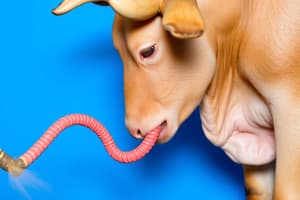Podcast
Questions and Answers
Why is the gradual adaptation of microflora important for carbohydrate digestion in ruminants?
Why is the gradual adaptation of microflora important for carbohydrate digestion in ruminants?
- It enhances the absorption of monosaccharides directly into the bloodstream.
- It ensures the efficient hydrolysis of beta-linked glucose polymers like cellulose.
- It prevents the accumulation of toxic levels of acetate. (correct)
- It allows the microflora to adjust to different types of carbohydrates, including those like lignin that are otherwise indigestible.
Which factor most significantly influences the absorption rate of volatile fatty acids (VFAs) and ammonia (NH3) in the rumen?
Which factor most significantly influences the absorption rate of volatile fatty acids (VFAs) and ammonia (NH3) in the rumen?
- The concentration of bicarbonate ions in saliva.
- The pH of the rumen.
- The presence of protozoa in the rumen. (correct)
- The animal's body temperature.
In what way do fermentative bacteria affect the biological value (BV) of dietary protein in ruminants?
In what way do fermentative bacteria affect the biological value (BV) of dietary protein in ruminants?
- They synthesize essential amino acids, increasing the quality of the protein.
- They prevent the catabolism of dietary protein, preserving its original BV.
- They increase the digestibility of proteins, allowing for better absorption. (correct)
- They can degrade high BV protein and synthesize bacterial protein with a different amino acid profile.
A dairy farmer notices several cows in their high-producing herd are losing weight and producing less milk despite adequate feed intake. Suspecting a nutritional deficiency related to microbial digestion, which of the following is most likely the cause?
A dairy farmer notices several cows in their high-producing herd are losing weight and producing less milk despite adequate feed intake. Suspecting a nutritional deficiency related to microbial digestion, which of the following is most likely the cause?
Why are young ruminants more dependent on dietary sources of essential amino acids, B-complex vitamins, and vitamin K compared to adult ruminants?
Why are young ruminants more dependent on dietary sources of essential amino acids, B-complex vitamins, and vitamin K compared to adult ruminants?
What is the primary role of facultative anaerobes in the rumen's microflora?
What is the primary role of facultative anaerobes in the rumen's microflora?
How does rapid Volatile Fatty Acid (VFA) absorption contribute to the health and stability of the rumen environment?
How does rapid Volatile Fatty Acid (VFA) absorption contribute to the health and stability of the rumen environment?
In a case of lactic acidosis caused by excessive grain feeding, what is the primary mechanism leading to the decreased rumen pH?
In a case of lactic acidosis caused by excessive grain feeding, what is the primary mechanism leading to the decreased rumen pH?
How does feeding a diet with a poor carbohydrate source in conjunction with a non-protein nitrogen source (like urea) lead to urea poisoning in ruminants?
How does feeding a diet with a poor carbohydrate source in conjunction with a non-protein nitrogen source (like urea) lead to urea poisoning in ruminants?
A horse is fed a diet high in poorly digestible fiber. How does the delayed passage of digesta impact the horse's digestive health?
A horse is fed a diet high in poorly digestible fiber. How does the delayed passage of digesta impact the horse's digestive health?
Flashcards
Cellulose to VFA
Cellulose to VFA
VFA production from cellulose makes energy available to the host animal.
Microbes and Amino acids
Microbes and Amino acids
Makes the host independent of dietary essential amino acids.
Microbes and Vitamins
Microbes and Vitamins
Makes the host independent of dietary B-complex vitamins (and K).
Facultative anaerobes
Facultative anaerobes
Signup and view all the flashcards
Environment Requirements
Environment Requirements
Signup and view all the flashcards
Insoluble carbohydrates
Insoluble carbohydrates
Signup and view all the flashcards
Soluble carbohydrates
Soluble carbohydrates
Signup and view all the flashcards
Volatile Fatty Acids (VFA)
Volatile Fatty Acids (VFA)
Signup and view all the flashcards
Dietary Protein in the Rumen
Dietary Protein in the Rumen
Signup and view all the flashcards
Cause of Lactic Acidosis
Cause of Lactic Acidosis
Signup and view all the flashcards
Study Notes
- Focus is on microbial digestion in animals, highlighting advantages, requirements, digestion of carbohydrates, and clinical correlations.
Advantages of Microbial Digestion
- Permits domestic herbivores to utilize energy from cellulose as volatile fatty acids (VFA).
- Cellulose contains β glycosidic linkages which can not be split by mammalian enzymes, and requires bacterial enzymes to digest.
- Ruminants can make essential amino acids regardless of diet because of microbes living within the gut.
- Adult foregut fermenters and coprophagous animals use bacterial structural and soluble proteins.
- High-producing dairy cows may require a source of essential amino acids to bypass the rumen due to selective breeding.
- Adult foregut fermenters and coprophagous animals can create their own B-complex vitamins and vitamin K.
- Water-soluble B vitamins are produced by microbial digestion.
- Fat-soluble vitamin K is produced by microbial digestion.
- Polioencephalomalacia (PEM) can be clinically relevant when there is a thiamine deficiency caused by ingesting thiaminase from bracken fern, but is not a dietary deficiency.
- Young ruminants have dietary requirements like monogastric animals because the microbial digestion process is not yet developed. .
Requirements for Microbial Digestion
- Two sites, the forestomach (in ruminants like cows and kangaroos) and the large intestine (cecum/proximal colon).
- The large intestine is important in the horse, pig, and rabbit, but less so in carnivores.
- Microflora includes facultative anaerobes, which can adapt in oxygen environments and grow best anaerobically.
- The rumen and large intestine lumen is anaerobic, but O2 enters with food and is quickly used.
- Aerobes enter with food but are short-lived.
- Protozoa scavenge bacteria, maintaining a healthy microbiome and increasing feed efficiency.
- A warm, buffered fluid medium is needed for digestion, especially in the rumen from saliva (HCO3- rich) and secretion across the rumen wall (passive HCO3- movement).
- The large intestine also requires buffered solutions from ileal outflow (HCO3- rich) and secretion across the wall (active and passive HCO3- secretion).
- Rapid absorption of VFA removes end-product inhibition and decreases the need for intraluminal buffering. Increased VFA lowers pH, killing some microbial populations.
- Delayed digesta passage slows digestion via motility patterns. Fiber length is proportional to transit time.
Microbial Digestion of Carbohydrates
- VFAs are produced: acetate (2C), propionate (3C), and butyrate (4C).
- VFAs are used as an energy source.
- Substrates:
- Cellulose (ẞ-linked glucose polymers/insoluble carbohydrates/grass type).
- Sugars, glycogen, starches (a-linked glucose polymers/soluble carbohydrates/grain type).
- Adaptation:
- Microflora must adapt to digest most carbohydrates except lignin (wood).
- Oxalates in plants can be toxic if not adapted (causes urinary stones).
- Lactate from grain can be toxic if it accumulates.
- End products of bacterial reactions happen in the rumen or large intestine.
- After microbial digestion, CO2 is released.
- Breakdown:
-Hexose (6C) converted to 2 Pyruvate (3C), then Acetyl CoA (2C), resulting in Acetate (2C).
- Hexose (6C) converted to 2 Pyruvate (3C), then Acetyl CoA (2C), resulting in Butyrate (4C) plus CO2.
- Hexose (6C) converted to 2 Pyruvate (3C), then OAA (4C) and Succ (4C), resulting in Propionate (3C).
- If Hexose (6C) converts to 2 Pyruvate (3C) and 2 Lactate (3C), it becomes Propionate (3C).
- Pyruvate is the common intermediate for all reactions.
Absorption of Weak Electrolytes (VFA and NH3)
- Weak electrolyte products of microbial digestion are absorbed via diffusion and pH dependence.
- VFA is a weak acid that donates H+ (proton), with HAc lipid soluble and passively absorbed and Ac not lipid soluble.
- NH3 weak base accepts protons, where NH3 is lipid soluble (passively absorbed) and NH4 is not lipid soluble (not absorbed - trapped in rumen).
- Absorption by diffusion is pH dependent.
- Uncharged species of weak electrolytes are more lipid soluble.
- The ratio of uncharged:charged depends on the luminal pH.
- Healthy rumen has a pH of 6.5.
- Increased HAc absorption results in more NH4 not being absorbed.
- Many oral drugs are weak electrolytes.
Microbial Digestion and Production of Protein
- Dietary protein in the rumen is catabolized and resynthesized to bacterial protein, where bacteria use NH3 + CHO to synthesize amino acids, purines, etc.
- Consider the biological value (BV) of dietary protein:
- Quality is the content of its essential amino acids. High content is meat, milk, etc.
- Digestibility, where highly digestible protein like leather is high quality but not digestible.
- Fermentative bacteria are a good BV protein source.
- Microbial digestion downgrades high BV protein, where bacterial protein upgrades low BV protein.
- It is unnecessary to feed high-quality protein to ruminants and nonprotein nitrogen sources (NPN) like urea with good CHO can be substituted.
- Around 20-30% of dietary protein bypasses rumen digestion, and microencapsulated amino acids can be used for high-producing dairy cows.
Clinical Correlations
Lactic Acidosis:
- Cause is too much lactate formed when soluble dietary CHO ferments.
- Two scenarios:
- CHO overload where animals that are adapted are overfed, kill off lactase production, increase VFA, decrease pH.
- Sudden change to soluble CHO concentrates where animals are not adapted to CHO load, and lactate producers increase but users do not.
- Lactate: stronger acid than VFA, poorly absorbed, has low pKa.
- Intraluminal acidosis damages the ruminal epithelium and draws ECF into the rumen, increasing intraluminal hyperosmolarity.
- Acute syndrome: epithelial damage, endotoxic shock, and hypovolemia.
- Sequelae: rumenitis, liver abscesses, and laminitis (founder) from inflammation and clotting in peripheral circulation.
Urea Poisoning
- Cause is NPN (urea) feeding with a poor CHO source, leading to ruminal alkalosis and more ammonia absorption.
- Low rate of VFA production.
- High input of alkaline saliva.
- Urea cycle in the liver is overwhelmed, and high blood NH3 causes CNS signs.
- To treat, acidify the rumen with vinegar (5% acetic acid).
Studying That Suits You
Use AI to generate personalized quizzes and flashcards to suit your learning preferences.




